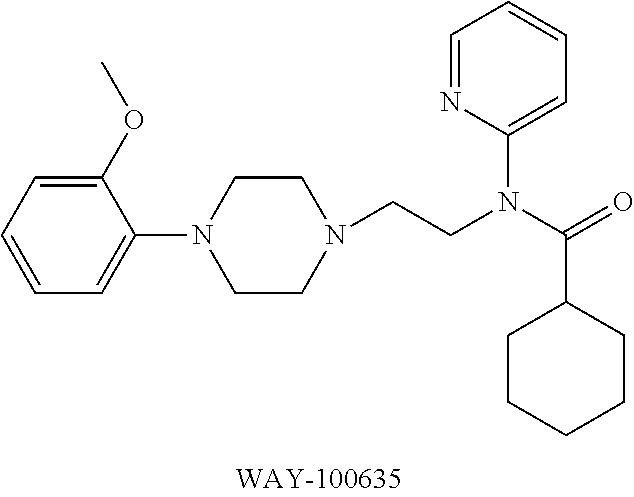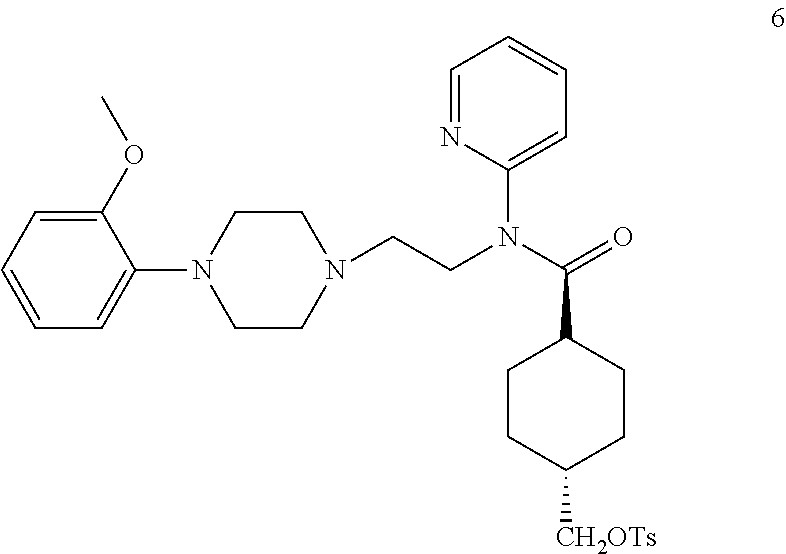Efficient synthetic method of 18f-mefway precursor
- Summary
- Abstract
- Description
- Claims
- Application Information
AI Technical Summary
Benefits of technology
Problems solved by technology
Method used
Image
Examples
example 2
Preparation of N-2-[2-{4-(2-Methoxyphenyl)-1-piperazinyl}ethyl]amidopyridine (2)
[0037]The mixture of 1-(2-methoxy)piperazine (0.20 mL, 1.17 mmol) and K2CO3 (0.40 g, 2.93 mmol) in DMF (8 mL) was stirred at 80° C. for 1 h. After cooling down to room temperature, a solution of compound (1) (0.20 g, 1.17 mmol) in DMF (2 mL) and sodium iodide (0.025 g, 0.17 mmol) were added to the mixture. The reaction mixture was stirred at 80° C. for 3 h, cooled to the room temperature. The organic layer was extracted with ethyl acetate, washed with water, and dried over anhydrous MgSO4. The residue was purified by flash column chromatography (50:1 CH2Cl2 / MeOH to 20:1 CH2Cl2 / MeOH) to give product (0.32 g, 84%) as pale yellow oil.
[0038]1H NMR (CDCl3, 300 MHz) 2.82-2.85 (m, 4H), 3.18 (s, 4H), 3.24 (s, 2H), 3.87 (s, 3H), 6.86-7.06 (m, 5H), 7.69-7.75 (m, 1H), 8.25-8.33 (m, 2H), 9.64 (s, 1H); 13C NMR (CDCl3, 75 MHz) δ 50.6, 53.8, 55.4, 62.3, 111.2, 113.9, 118.4, 119.9, 121.0, 123.2, 138.3, 140.9, 148.0, 151...
example 3
Preparation of N-2-[2-{4-(2-Methoxyphenyl)-1-piperazinyl}ethyl]-N-(2-pyridinyl)amine (3)
[0039]1 M LiAlH4 / THF (6.70 mL, 6.70 mmol) was slowly added to a solution of compound (2) (0.73 g, 2.24 mmol) in dry THF (10 mL) at 0° C. The mixture was stirred at room temperature under an Ar atmosphere for 3 h. After quenching with saturated aqueous NH4Cl at 0° C. for 30 min, the mixture was filtrated with ethyl acetate. The organic layer was extracted with ethyl acetate, washed with water, and dried over anhydrous MgSO4. The residue was purified by flash column chromatography (50:1 CH2Cl2 / MeOH to 20:1 CH2Cl2 / MeOH) to give product (0.53 g, 76%) as pale yellow oil.
[0040]1H NMR (CDCl3, 300 MHz) δ 2.68-2.72 (m, 6H), 3.10 (s, 4H), 3.36-3.41 (m, 2H), 3.87 (s, 3H), 5.14 (s, 1H), 6.40-6.43 (d, 1H, J=8.4 Hz), 6.54-6.59 (m, 1H), 6.85-7.04 (m, 4H), 7.39-7.45 (m, 1H), 8.08-8.11 (m, 1H); 13C NMR (CDCl3, 75 MHz) δ 38.5, 50.7, 53.1, 55.3, 56.8, 107.0, 111.1, 112.7, 118.2, 121.0, 122.9, 137.3, 141.3, 148.2, 1...
example 4
Preparation of trans-N-2-{2-[4-(2-Methoxyphenyl)piperazinyl]ethyl}-N-(2-pyridyl)-N-(4-carboxymethylcyclohexane)carboxamide (4)
[0041]Oxalylchloride (0.19 mL, 2.13 mmol) was added to a solution of trans-4-carbomethoxycyclohexane-1-carboxylic acid (0.20 g, 1.05 mmol) in dry CH2Cl2 (10 mL), and the mixture was refluxed for 2 h. After removing solvent and unreacted oxalylchloride in vacuo, the product was re-dissolved in dry CH2Cl2. Compound (3) (0.22 g, 1.05 mmol) and TEA (0.16 mL, 1.14 mmol) were added to the previous product at 0° C. The reaction mixture was stirred at room temperature under an Ar atmosphere for 2 h. After the mixture was washed with 10% aqueous NaHCO3 (100 mL), the organic layer was extracted with CH2Cl2, and dried over anhydrous MgSO4. The residue was purified by flash column chromatography (ethyl acetate, 0.1% v / v TEA) to give product (0.28 g, 83%) as pale yellow oil.
[0042]1H NMR (CDCl3, 300 MHz) δ 1.17-1.25 (m, 2H), 1.62-1.66 (m, 2H), 1.84-1.96 (m, 4H), 2.25-2.29 ...
PUM
 Login to View More
Login to View More Abstract
Description
Claims
Application Information
 Login to View More
Login to View More - R&D
- Intellectual Property
- Life Sciences
- Materials
- Tech Scout
- Unparalleled Data Quality
- Higher Quality Content
- 60% Fewer Hallucinations
Browse by: Latest US Patents, China's latest patents, Technical Efficacy Thesaurus, Application Domain, Technology Topic, Popular Technical Reports.
© 2025 PatSnap. All rights reserved.Legal|Privacy policy|Modern Slavery Act Transparency Statement|Sitemap|About US| Contact US: help@patsnap.com



